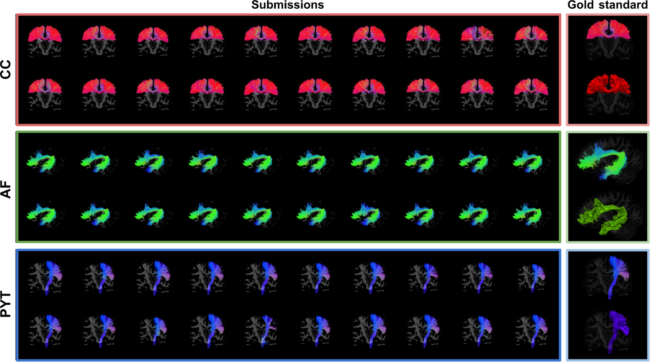Tractostorm 2: Optimizing tractography dissection reproducibility with segmentation protocol dissemination
Rheault, Francois, Kurt G. Schilling, Alex Valcourt-Caron, Antoine Théberge, Charles Poirier, Gabrielle Grenier, Guido I. Guberman, John Begnoche, Jon Haitz Legarreta, Leon Y. Cai, Maggie Roy, Manon Edde, Marco Perez Caceres, Mario Ocampo-Pineda, Noor Al-Sharif, Philippe Karan, Pietro Bontempi, Sami Obaid, Sara Bosticardo, Simona Schiavi, Viljami Sairanen, Alessandro Daducci, Laurie E. Cutting, Laurent Petit, Maxime Descoteaux and Bennett A. Landman “Tractostorm 2: Optimizing tractography dissection reproducibility with segmentation protocol dissemination” Human Brain Mapping (2022): 1-14.
Abstract
Purpose: The first iteration of Tractostorm quantified the variability of a pyramidal tract dissection protocol and compared results between experts in neuroanatomy and nonexperts. Despite virtual dissection being used for decades, in-depth investigations of how learning or practicing such protocols impact dissection results are nonexistent. To begin to fill the gap, we evaluate an online educational tractography course and investigate the impact learning and practicing a dissection protocol has on interrater (groupwise) reproducibility.
Methods: To generate the required data to quantify reproducibility across raters and time, 20 independent raters performed dissections of three bundles of interest on five Human Connectome Project subjects, each with four timepoints. The goal is to evaluate the evolution of reproducibility scores as raters perform more and more segmentation.
Results: Our investigation shows that the dissection protocol in conjunction with an online course achieves a high level of reproducibility (between 0.85 and 0.90 for the voxel-based Dice score) for the three bundles of interest and remains stable over time (repetition of the protocol). Suggesting that once raters are familiar with the software and tasks at hand, their interpretation and execution at the group level do not drastically vary.
Conclusions: When compared to previous work that used a different method of communication for the protocol, our results show that incorporating a virtual educational session increased reproducibility. Insights from this work may be used to improve the future design of WM pathway dissection protocols and to further inform neuroanatomical definitions.
